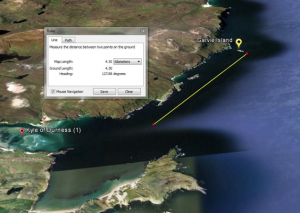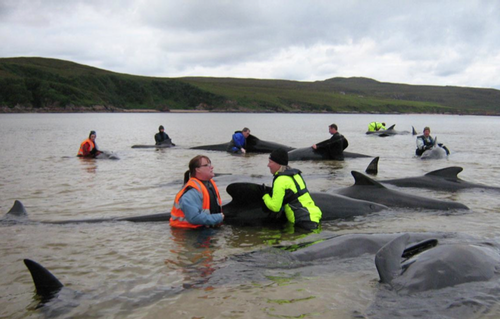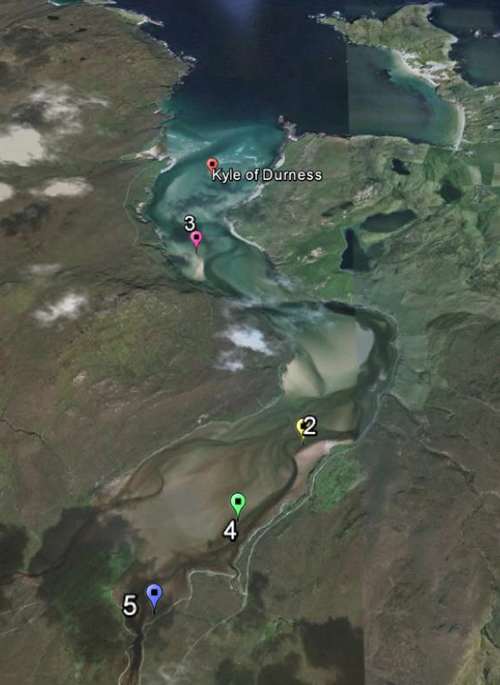2011 stranding blamed on Royal Navy bomb explosions
Effects of Noise on Wildlife, News, Ocean Add comments In July 2011, 70 pilot whales were spotted in the shallow Kyle of Durness on the north coast of Scotland; as the tide went out, at least 39 were stranded. Quick efforts by locals and live-stranding groups managed to refloat 20 animals, but 19 perished. This month, a report commissioned by the UK’s governing agency, DEFRA, concluded that a series of bomb-disposal explosions were the most likely cause of the stranding. It’s a good reminder that much of the potential impact on wildlife from Navy exercises is from traditional ordinance, rather than sonar.
In July 2011, 70 pilot whales were spotted in the shallow Kyle of Durness on the north coast of Scotland; as the tide went out, at least 39 were stranded. Quick efforts by locals and live-stranding groups managed to refloat 20 animals, but 19 perished. This month, a report commissioned by the UK’s governing agency, DEFRA, concluded that a series of bomb-disposal explosions were the most likely cause of the stranding. It’s a good reminder that much of the potential impact on wildlife from Navy exercises is from traditional ordinance, rather than sonar.
While pilot whales are relatively common around Scotland, and there have been numerous strandings through the years, it’s unusual that they would venture into such a shallow, tidal bay. It seems likely that the pod was in the area relatively near shore (either following food, or transiting between feeding locations) when several bombs were exploded on the day before the stranding (yellow pointer on image). Navigational error (perhaps caused by hearing impairment) left them in the mouth of the bay (red pointer), 3-5 miles away, rather than offshore; the strandings had just begun when the final bomb was exploded the next day, which likely drove more animals into the shallows.
The report suggests that some whales may well have been close enough to suffer temporary or permanent hearing damage. In the most damning finding, it appears clear that monitoring for nearby animals was cursory at best, done only from small inflatable boats:
Given the precise nature of the sound profile and resultant acoustic trauma is a complex function of environmental and bathymetric factors, it is difficult to precisely establish the radius for these (hearing-impairment) effects. Based on other studies it is likely that this radius is greater than the maximum distance it was possible for observers on the NDG vessel to see from a rigid inflatable boat based observation platform less than 2 m above sea level. The only surveillance for cetaceans in the vicinity of Garvie Island prior to detonation of the underwater munitions was from this single platform by personnel not familiar with observing marine mammals. It would not have been possible therefore to effectively assess if animals were within the envelope where acoustic damage was likely.
Further, explosions are not the only option available for safely deactivating ordinance left behind by training missions; an alternative method that burns them instead is widely used around the world. “Given the potential damage to marine life from the high-order explosions of conventional disposal techniques, it is questionable why this method has not been used routinely in the past,” the report says.
Sarah Dolman of Whale and Dolphin Conservation, said: “Why has it taken four years to publish the report and what measures have the Ministry of Defence (MoD) put in place to evaluate and minimise the impacts of detonations around Garvie Island, to ensure that it adequately protects whales and dolphins since then?”
Rob Gibson, local representative to the Scottish Parliament, agreed: “The fact that it took four years for this report to be published and for the UK government to accept that they are to blame is ridiculous. The efforts of the local people in the Kyle of Durness to save the beached whales were incredible – but sadly the animals could not be saved and many died. Scotland’s seas are blessed with many marine mammals, including more than 20 species of whales, dolphins and porpoises. It is our responsibility, where possible, to do all we can to protect these wonderful and popular species.”
For their part, the Royal Navy offered a largely unsatisfying response: “The recommendations will be considered by the MoD and implemented where appropriate.” The Navy stressed that they’ve been exploding bombs for decades without signs of strandings, and that since the 2011 event, they have added unspecified new mitigation practices.
Below are two more images from the report; the first of refloating efforts underway, and the second indicating the areas in the kyle where strandings occurred.


